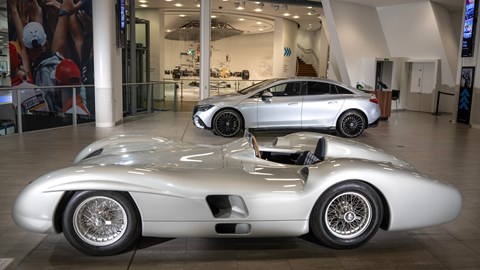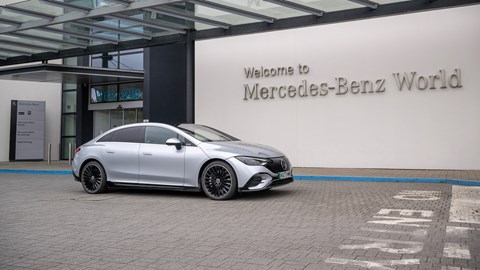► Month 3 with the EQE
► We take a closer look at the aero
► Read month 2 here
Electric cars are hugely reliant on being able to carve cleanly through the air, maximising efficiency so they get an acceptable number of miles per charge. In pure energy terms, our Mercedes EQE’s 89kWh battery contains 320,000 kilojoules of fizz. A 60-litre tank of petrol has about 2,000,000.
Join me as I attempt to improve my rather poor grasp of aerodynamics – a journey illustrated not by pie charts and line graphs, but by photos of my EQE with a rather more attractive Mercedes. The W196 R you see here is not the real thing from the mid ’50s but a life-size model on display at Mercedes-Benz World in Brooklands. It shows how glorious a car can be when aerodynamic efficiency is at the forefront of the designer’s mind.

Without the constraints of modern legislation and the EQE’s requirement to actually carry normal sized human beings in comfort, the W196 is a thing of beauty. It’s wonderfully pure and purposeful, with every element of the bodywork crafted to ensure that the 255bhp from the 2.5-litre inline eight gets maximum return from each rotation of its crank. Yes, just 255bhp.
The aero wasn’t the only ground-breaker, as the engine had direct injection and desmodromic valve control, whereby it didn’t need return springs.
Its first race was at the high-speed Reims-Gaux circuit with Juan Manuel Fangio and Karl Kling; they finished one-two. But as Mercedes found out later, being slippery isn’t necessarily the answer to everything. Aerodynamics and the compromises between efficiency, drag and lift are hugely complicated. A lot is asked of the modern aero engineer to ensure a car does what it needs to do on the road, with myriad variables to contend with.

Take our EQE. Mercedes has chased an enviably low drag co-efficient to help increase the car’s range, getting it down to just 0.22 (as opposed to 0.20 in the longer EQS, a difference that equates to about 12 miles of range), helped by some really clever details.
As Mercedes aerodynamicist Uwe Seidler tells me, one bonus of an EV is that you can create a completely flat floor, giving a much cleaner flow. They always wanted to do it on combustion cars but were prevented by the need to dissipate the heat from the engine. Because it’s out of sight it doesn’t need to look pretty, so the aero department has gone so far as to cover the screw heads with glued-on pads, yielding an extra half-mile or so of range.
Curiously, they tried the same thing on the similar-looking EQS and it made no difference to the drag coefficient.

Seidler and his boss, Alexander Mueller, head of aerodynamics, show me a diagram of the underside of the car where it’s quite clear there are gaps in the floor around the wheels. They tried filling those in but found it made things worse, as the flows of air around the wheels, tyres and rear bumper need to interact with each other. It became too smooth.
Tiny differences yield huge results: adding a tow bar might make your weekly trip to the tip easier, but it’ll also knock nearly two miles off the EQE’s range.
Of course, the ultimate problem with all this is that despite the clever aero – the ‘cheapest way’ to increase range, according to Mueller – the EQE has looks that only a mother could love. It’s certainly no W196.
If Seidler had his way, the EQE would be 70cm tall and look much more like the super-slick EQXX concept. But when there are passengers involved, there’s only so much an aerodynamicist can do.
Logbook: Mercedes-Benz EQE 300 AMG Line Premium Plus (month 3)
Price £86,345
Performance 89kWh battery, e-motor, 241bhp, 7.3sec 0-62mph, 130mph
Efficiency 3.3 miles per kWh (official), 2.25 miles per kWh (tested)
Range 337 miles (official), 240 miles (tested)
Energy cost 17.0p per mile
Miles this month 818
Total miles 1840